Sail Anatomy
Go To: Sailing - Learn To Sail
Posted on 28 January 2008 18:20
When you first get into a sailing dinghy, it can be hard to figure out what everything is, let alone what it does! Find out about the sails, in our guide.
A sail on a sailing dinghy or yacht is one of the most simplest forms of propulsion there is - but that doesn't mean to say it's easy to understand. Unfortunately, it's not quite as simple as pulling it up and letting it flap - that won't get you anywhere; instead, you need to know what each control for the sail does, and how to use them. In this guide, we explain the layout of a basic sail.
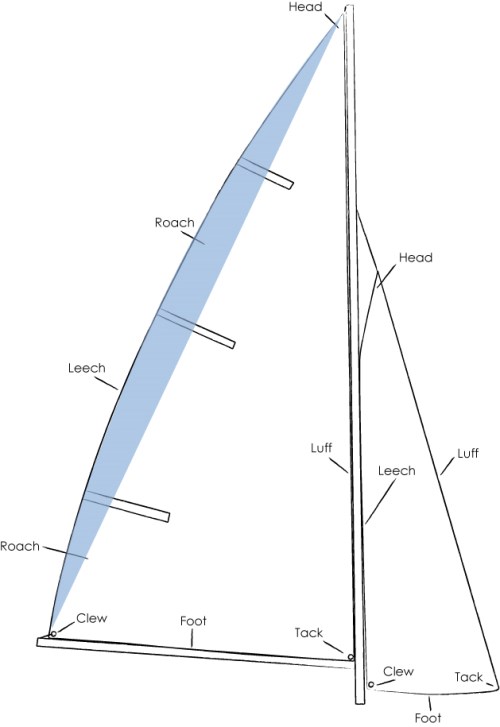
Diagram of a sail
Types of Rig
There are several different layouts for sails on a boat; the one you may be most familiar with is square rigging, which was found on old pirate ships, clippers, and other ships of the same era, and would have a boom of sorts at the top and bottom of the sails. The "Lugger" is another type, which would typically have two masts, with the boom at the top of the sail rather than the bottom. "Gaff" rigged boats again have a boom at the top and bottom of the sail, although the boom at the top is called the gaff. The typical sail arrangement found on most sailing dinghies however, is the Bermudian rig, where the sail is for the most part triangular in shape, and we shall be concentrating on that one. This is your typical sail for Enterprises, Lasers, skiffs, pretty much any modern sailing dinghy of the last 40 years.
Types of Sail
There are also plenty of different types of sail, usually different in size, shape and function depending on the location on the boat. The main sail is literally called the mainsail, and usually sits in the aft (back) half of the boat. This sail gives the boat most of its drive. A jib sail is a smaller sail that sits on the front of the boat (see Picture 1); Jibs are also sometimes called genoas. The other and final type of sail we will talk about is called the spinnaker, and this is a large sail that is hoisted at the front of the boat when sailing downwind (symmetrical spinnakers) or slightly off downwind (asymmetrical spinnakers). To see the general picture of how sails should be set sailing at different directions to the wind, see our Article on Points Of Sail.
To better understand how a sail works, we recommend you also read our Article on Sail Pressure, which will explain how sails use the wind to move - it may surprise you to find out that not only do boats get pushed along by the wind blowing into the sails, but they also get pulled along by the wind sucking at the sails!
Sail Anatomy
Any triangular sail has the same basic layout, as shown in Picture 1. The leading edge is called the luff, whereas the back edge is called the leech. The top of the sail is known as the head, the bottom back corner the clew, and the bottom front corner where it sits between the boom and mast is called the tack. The foot of the sail is called the foot. The area shaded in blue on the Sail Diagram is called the roach, and this is the main area of the sail which will curve in wind, forming the sail shape.
There are some other relevant parts to a sail, which can be seen in Picture 2. Battens are lengths of either thin strips of wood laminate or some form of plastic, which fit into batten pockets on the sail, and basically help the sail form a better shape. Telltales help you tell how much you need to alter the sail trim (see our Article on Using Telltales) by their various flutterings, and reefing points allow you to use a smaller sail in strong wind conditions (see our Article on Reefing).
Sail Control
You have to control sails to get them to do what you want to do - and there are several methods of doing this.
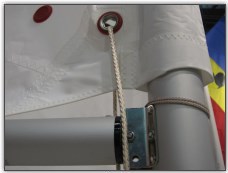
Photo 1. Downhaul
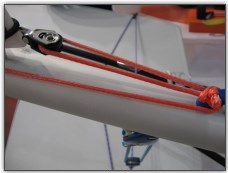
Photo 2. Outhaul
Every sail will typically have a sheet or sheets; these are lines or ropes coming off part of the sail, or a spar that the sail is attached to. The mast and boom are the two common spars you will find on a boat. You will usually find the mainsail is attached to the boom at it's foot, either by the sail running inside the length of the top of the boom (e.g. an Enterprise) or the sail is attached firmly to the mast, and attached to the boom at the clew (e.g. a Laser or Topper). The main sheet will then usually be attached to the underside of the boom, so that pulling on the main sheet pulls down the boom, which as it is attached to the sail, trims the sail and pulls it in. Why isn't the mainsheet directly attached to the sail? Quite simple - the boom helps the sail form a better, more aerodynamic and efficient shape.
You'll usually get various different arrangements of blocks that the mainsheet goes through; these are to increase the torque on the line using a pulley system, to increase the amount of force you can leverage for energy you can put into it (it makes it easier!).
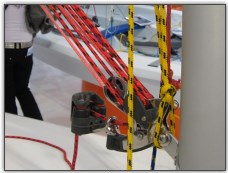
Photo 3. Kicking Strap
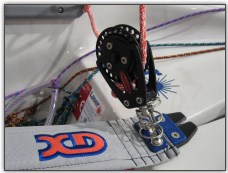
Photo 4. Main Block
You also get several other controls on a sail; the outhaul usually goes from the clew (back bottom corner) of the sail to the back end of the boom, and is used to control the amount of curve in the sail. The downhaul, sometimes known as the Cunningham, can be seen in picture 2 and is on the front edge of the sail. Tightening the downhaul moves the curve of the sail forward, and forces wind out of the sail, depowering it. The final sail control is the kicking strap, which controls the sail by pulling down on the boom, and again helps control the shape of it. For more information on fine tuning sail trim and sail controls, see our Article on Sail Trim.
Raising and Lowering Sails
The best time to raise and lower a sail differs on who you speak to; some people firmly believe that you should only ever raise a mainsail when the boat is on the water, so any wind will not push the sail and possibly the boat around. However, provided you can turn the boat so it is pointed head to wind, and you do not have very far to get to the water, there is no reason why you cannot hoist the sails on land, unless the wind conditions are very strong.
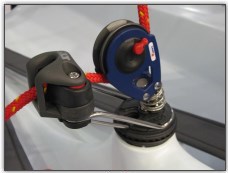
Photo 5. Mainblock

Photo 6. Main Block
The mainsail and jib are raised by pulling on halyards; these are ropes that usually go either up inside or along the outside of the mast, with one end attached to the head of the sail. When hoisted, the other end should be cleated or tied off around a cleat or jammed in a jammer. On some larger boats in particular, special devices help to roll the sail; you can find similar devices on jibs on smaller boats, and they are called jib furlers.
Obviously with single handed boats with unstayed masts, such as lasers or toppers, you do not have to hoist the sail as such, as the sail fits over the mast and cannot be lowered. However, toppers do have a halyard, to tighten the luff of the sail up. In strong conditions in these boats, avoid attaching the outhaul until the last possible moment, even on the water if at all possible. Until the outhaul is attached, the sail will not pick up power.
Spinnakers should not be raised on land. Spinnakers can only be raised when the wind is coming from the correct direction; this is typically just off to the side of sailing downwind (see our Article on Points Of Sail). Depending on the type of spinnaker, a different approach is required. For symmetrical spinnakers, often the crew will need to throw it under the jib sail (spinnakers are hoisted outside of the jib) as the helm hoists the sail via the halyard, and it is held outwards using a spinnaker pole. Assymetrical spinnakers however usually come out of launch chutes in the foredeck, and the crew can just hoist it themselves, while the sail is held out in front of the boat with the one corner attached to the tip of the bowsprit.
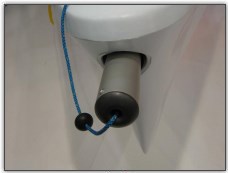
Photo 7. Spinnaker Bowsprit
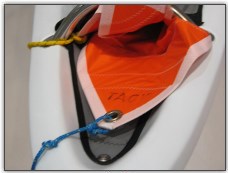
Photo 8. Spinnaker Chute
Summary
As you can see, for a simple method of propulsion, there really is a lot to it! There's no magical formula for figuring out what a sail does; you can learn all of the above until you can recite it word for word, but nothing beats practise, to figure out what to do with your sail, and when. For more information on just how to use the power in a sail, see our articles on Sail Trim and Sail Settings, Tacking, Reefing, Using Telltales, and Points Of Sail.